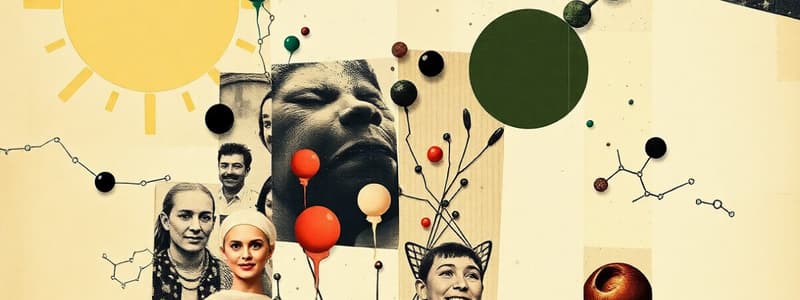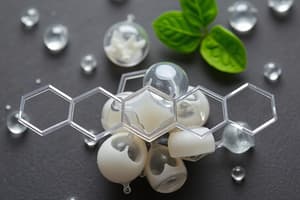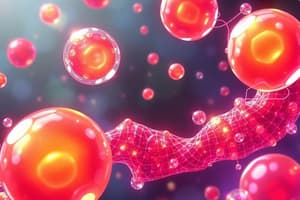Podcast
Questions and Answers
Which type of vegetarian only consumes chicken?
Which type of vegetarian only consumes chicken?
- Pescatarians
- Lacto-ovo Vegetarians
- Pollo Vegetarians (correct)
- Vegans
Which of the following health risks does a plant-based diet help decrease?
Which of the following health risks does a plant-based diet help decrease?
- Liver Disease
- Cardiovascular Issues (correct)
- Acid Reflux
- Skin Conditions
What is one nutritional benefit of a plant-based diet?
What is one nutritional benefit of a plant-based diet?
- Low in fiber
- Higher in vitamins and minerals (correct)
- Contains more animal products
- High in saturated fat
Which of the following groups excludes all animal products from their diet?
Which of the following groups excludes all animal products from their diet?
Which claim is true regarding protein intake on a plant-based diet?
Which claim is true regarding protein intake on a plant-based diet?
What is the primary building block of lipids?
What is the primary building block of lipids?
Which type of fat is considered the best for health?
Which type of fat is considered the best for health?
Which essential fatty acid is known to lower cholesterol?
Which essential fatty acid is known to lower cholesterol?
What is a characteristic of monounsaturated fats?
What is a characteristic of monounsaturated fats?
What percentage of total calories is recommended for fat intake?
What percentage of total calories is recommended for fat intake?
Which fatty acid is noted for preventing blood clots?
Which fatty acid is noted for preventing blood clots?
What is a function of fats in the body?
What is a function of fats in the body?
Which option describes a characteristic of polyunsaturated fats?
Which option describes a characteristic of polyunsaturated fats?
Which type of fat has the highest saturated fat content?
Which type of fat has the highest saturated fat content?
What is one of the primary functions of cholesterol in the body?
What is one of the primary functions of cholesterol in the body?
What is the result of consuming too much artificial trans fat?
What is the result of consuming too much artificial trans fat?
Which of the following is a non-digestible artificial fat?
Which of the following is a non-digestible artificial fat?
What is the role of bile in fat digestion?
What is the role of bile in fat digestion?
What is one consequence of insufficient fat intake in children?
What is one consequence of insufficient fat intake in children?
Which process occurs first in the digestion of lipids?
Which process occurs first in the digestion of lipids?
What happens when the body has excessive fat?
What happens when the body has excessive fat?
Which mineral in the diet is known to help lower blood pressure?
Which mineral in the diet is known to help lower blood pressure?
What dietary habit can significantly reduce iron absorption?
What dietary habit can significantly reduce iron absorption?
What is not a controllable risk factor for developing osteoporosis?
What is not a controllable risk factor for developing osteoporosis?
Which age-related change occurs to bone mass after the age of 30?
Which age-related change occurs to bone mass after the age of 30?
Which of the following symptoms is associated with iron deficiency?
Which of the following symptoms is associated with iron deficiency?
Which vitamin is known for its potential toxicity when consumed in excess?
Which vitamin is known for its potential toxicity when consumed in excess?
What is a common sign of Vitamin B-12 deficiency?
What is a common sign of Vitamin B-12 deficiency?
Which group of individuals may require higher amounts of Vitamin C due to risk factors?
Which group of individuals may require higher amounts of Vitamin C due to risk factors?
What should be consumed to enhance the absorption of calcium?
What should be consumed to enhance the absorption of calcium?
Which of the following foods is a significant source of iron?
Which of the following foods is a significant source of iron?
Which vitamin is essential for collagen synthesis and keeping skin supple?
Which vitamin is essential for collagen synthesis and keeping skin supple?
The bioavailability of minerals can be negatively affected by which dietary factor?
The bioavailability of minerals can be negatively affected by which dietary factor?
Which vitamin is important for the function of Vitamin K in blood clotting?
Which vitamin is important for the function of Vitamin K in blood clotting?
Flashcards are hidden until you start studying
Study Notes
Lipids (Fats & Oils)
- Fats are solid at room temperature.
- Oils are liquid at room temperature.
- The building blocks of lipids are triglycerides, a combination of one glycerol molecule and three fatty acid molecules.
- Lipids function as fuel, carrying essential fatty acids and fat-soluble vitamins (A, D, E, & K).
- Lipids provide insulation and protection for the body, acting as a protective layer for internal organs.
- They are essential components of cell membranes.
- Lipids contribute to satiety, adding flavor and texture to food.
- The USA does not have daily fat intake recommendations.
- Recommended daily fat intake:
- Less than 30% of total daily calories.
- 10% saturated fats.
- 10% monounsaturated fats.
- 10% polyunsaturated fats.
Polyunsaturated Fats
- Considered the best type of fat.
- Liquid at room temperature and stay liquid when chilled.
- Include Omega-6 and Omega-3 fatty acids.
- Omega-6 fatty acids are heart-friendly, lowering cholesterol levels.
- Examples of Omega-6 fatty acids:
- Linoleum acid.
- Sources: soybean and canola oil, nuts.
- Omega-3 fatty acids are heart-friendly, preventing blood clots and protecting artery walls from damage.
- Examples of Omega-3 fatty acids:
- Linolentic acid
- Sources: Cold-water fish, canola oil, soybeans, olive oil, nuts.
Monounsaturated Fats
- Considered good for you.
- Liquid at room temperature and thicken when chilled.
- Found in most nuts and olive, canola, and peanut oils.
Saturated Fats
- Considered bad for you.
- Solid at room temperature and harden when chilled.
- Found in animal foods and some plant foods like coconut oil and palm oil.
- Increase the risk of heart disease.
Cholesterol
- A fat-like substance found only in animal products.
- Not used for energy and has no calories.
- Plays a role in the production of estrogen and testosterone.
- Aids in the conversion of sunlight on the skin into vitamin D.
- A major component of nerves and the brain.
- Found in every cell.
- The body produces cholesterol if it isn't obtained through the diet.
- Two sources of cholesterol:
- The body.
- Animal fat.
Trans Fat (Artificial Fat)
- Artificially produced fats created through hydrogenation, a process that fills empty spots in polyunsaturated (vegetable oils).
- Found in many processed foods.
- Can be identified in ingredient lists as:
- Hydrogenated fat.
- Hydrogenated Oil.
- Partially Hyderogenated fat.
Artificial Fat Examples
- Simplesse:
- Low-calorie artificial fat made from milk protein and water.
- Found in frozen desserts.
- Olestra (or Olean):
- Non-digestible fat made from sugar and oil compounds.
- Cannot be digested or absorbed by the body, so it provides no calories.
Lipid Digestion, Absorption, and Metabolism
- Digestion:
- Begins in the stomach through mechanical digestion.
- Gastric acid and enzymes, such as lipase, break down triglycerides into diglycerides.
- Fat is water-insoluble and takes longer to leave the stomach (2-9 hours).
- Continues in the small intestine where triglycerides and diglycerides are further broken down into fatty acids and glycerol with the help of bile.
- Bile is produced in the liver, stored in the gallbladder, and released into the small intestine.
- Bile emulsifies fat, breaking it down into smaller droplets to aid in digestion.
- Pancreatic enzymes (lipase) are released into the small intestine to aid in digestion.
- Absorption:
- Most absorbed through the small intestine.
- Metabolism:
- Liver plays a key role.
- Fats are used for energy or stored for later use.
Consequences of Fat Deficiency
- Intolerance to cold temperatures.
- Stunted growth in children.
- Skin deterioration.
- Women may experience menstrual irregularities and infertility.
Consequences of Excessive Fat Intake
- Obesity: Excessive accumulation of body fat.
- Heart disease: Leading cause of death in the USA and Canada.
- Cancer.
Vegetarian Diets
- Lacto-ovo Vegetarians: Avoid meat but consume dairy and eggs.
- Pescatarians: Consume fish.
- Pollo Vegetarians: Only eat chicken but avoid other meats.
- Vegans: Exclude all animal products.
- Plant-based diets can provide 100% of the protein your body needs.
- Plant-based diets are linked to lower risks of:
- Heart disease.
- Stroke.
- High blood pressure.
- Diabetes.
- Obesity.
- Chronic bronchitis.
- Gallstones.
- Kidney stones.
- Colon cancer.
- Plant-based diets offer benefits:
- Lower in saturated fat.
- High in fiber.
- Higher in vitamins, minerals, and phytochemicals.
Vitamins
- Folic acid is vital for preventing:
- Heart disease.
- Stroke.
- Colon cancer.
- Birth defects.
- Breast cancer.
- B-12 deficiency signs:
- Memory loss.
- Mental confusion.
- Blurred vision.
- Tingling in the feet.
- Vitamin C is crucial for maintaining supple skin through collagen synthesis.
- Fat-soluble vitamins can be stored in the body:
- Vitamin A:
- Pre-formed sources:
- Animal liver.
- Supplements.
- Can be toxic in high doses.
- Beta-carotene sources:
- Plants.
- Not toxic.
- Pre-formed sources:
- Vitamin E: Acts as an antioxidant to prevent free radical damage.
- Vitamin D: Essential for bone health.
- Vitamin K: Crucial for blood clotting.
- Sources: Leafy greens, cabbage, also produced by the body.
- Vitamin A:
Groups Requiring Extra Vitamins
- Smokers: Need 66% more vitamin C. Depletion also linked to passive smoke.
- Vegetarians: May need vitamin D and B-12.
- Pregnant and breastfeeding women.
- Menopausal women:
- Vitamin D.
- Calcium.
- Individuals over 50:
- B-12.
Maximizing Vitamin Intake
- At the grocery store:
- Aim for 5 or more servings of fruits and vegetables daily.
- Choose whole grain products.
- Look for opaque containers to retain riboflavin in foods.
Vitamin Destroyers
- Water: Washing vegetables after chopping can reduce vitamin content.
- Heat: Cooking can destroy some vitamins.
Minerals
- Single atoms that cannot be created or destroyed.
- Bioavailability: The amount of a nutrient available for absorption and use by the body.
- Factors reducing bioavailability:
- High fiber diets.
- Individual mineral supplements.
- Factors increasing bioavailability:
- Vitamins can enhance the absorption of minerals.
- Vitamin D and calcium.
- Vitamin C and iron.
- Vitamins can enhance the absorption of minerals.
- Beef is a good source of iron.
- Iron in the blood is crucial for:
- Transportation of oxygen in arteries.
- Transportation of carbon dioxide in veins.
- Symptoms of iron deficiency:
- Short attention span.
- Poor appetite.
- Weakness and fatigue.
- Increased risk of infections.
- Pale skin.
- Increased heart rate.
- For infants and children: Mental retardation.
- Ways to increase iron intake:
- Cook food in iron pans.
- Consuming tea with meals reduces iron absorption by 50%.
Electrolytes:
- Potassium: Dietary intake helps lower blood pressure.
Preventing High Blood Pressure
- Reduce sodium intake.
- Exercise regularly.
- Consume low-fat dairy products.
- Eat a diet rich in fruits and vegetables.
DASH Diet (Dietary Approaches to Stop Hypertension)
- Low in:
- Total fat.
- Saturated fat.
- Cholesterol.
- Sodium.
- Emphasizes:
- Fruits.
- Vegetables.
- Fat-free or low-fat milk and dairy products.
Osteoporosis
- A painful and crippling bone disease where bones become thin and brittle, making them more susceptible to fractures.
- The "silent disease" because early stages often have no noticeable symptoms.
- Bone cycle:
- Childhood: More bone is formed than removed.
- After age 30: More bone is removed than formed.
- Causes:
- Can begin at a young age:
- Insufficient calcium and vitamin D intake leads to low bone mass.
- Menopause:
- Decreased estrogen production impacts calcium metabolism.
- Can begin at a young age:
- Risk factors:
- Uncontrollable:
- Gender (women are more susceptible).
- Family history.
- Race (Caucasians are at higher risk).
- Controllable:
- Being underweight.
- Smoking.
- Heavy alcohol consumption.
- Exercise less than 3 times a week.
- Dietary intake of less than 2 servings of dairy or a diet low in vitamin D.
- Uncontrollable:
Studying That Suits You
Use AI to generate personalized quizzes and flashcards to suit your learning preferences.




